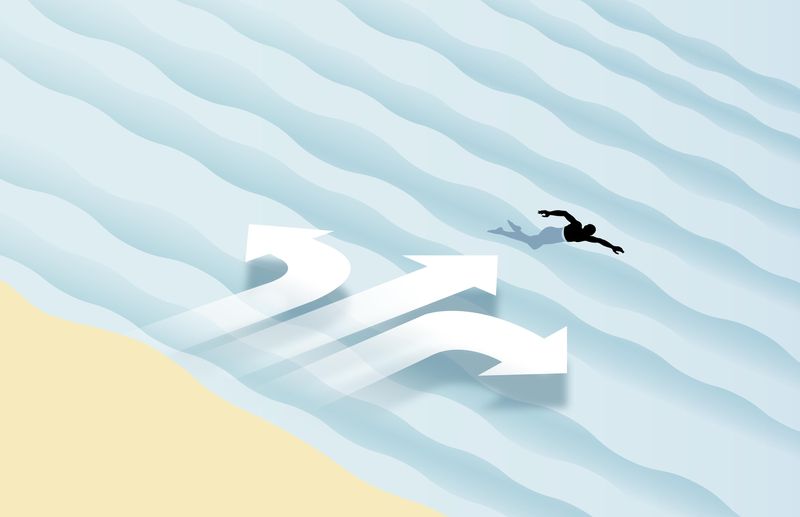
Hurricane Erin will spare the U.S. East Coast a direct landfall, but will stir up life-threatening surf conditions along the entire Atlantic Coast from Florida to Canada's maritime provinces.
Emergency officials and the National Weather Service are pleading with people to use caution and stay out of the water at the beach to avoid hazardous rip currents that often cause deaths during offshore hurricanes.
"Knee deep is too deep," said Andrew Shashy, a meteorologist with the Jacksonville weather service office in Florida.
Erin's influence over conditions at the coast is increasing because the hurricane is "expected to grow rather dramatically in size,” National Hurricane Center Director Michael Brennan said during an Aug. 18 briefing. “This is going to make for very dangerous marine conditions across all of the western Atlantic, and increase the risk for dangerous and life-threatening surf and rip current conditions across almost the entire U.S. East Coast."
What are rip currents?
Rip currents are narrow, strong currents that flow quickly away from shore, often perpendicular to the shoreline.
Typically, the water carried toward the tideline by waves flows back out to sea in a uniform way. But a low spot in the ocean, a channel gouged down into the sand on the ocean surface, or a break in a sandbar, can disrupt that flow and push water through the spot to create a current much more powerful than the surrounding flow.
The speed of that flow can be as much as 5.5 mph – faster than even an Olympic swimmer. The strength and speed can overpower even strong swimmers.
“These are going to be situations where you’re not going to want to be in the ocean, and you're going to want to heed any precautions given by your local officials,” Brennan said. “Even though the weather can be nice at the coast, it can still have dangerous surf and rip current conditions from a hurricane that's well offshore, like we're going to Erin.”
The highest one-third of its waves could exceed 20 to 30 feet, and even 50 feet near the storm’s center, he said.
Surf zone fatalities
So far in 2025, at least 25 rip current deaths have been reported by the weather service, as well as four deaths from high surf. There have been at least 52 total deaths in the surf zones, including other hazards, such as sneaker waves and longshore currents. Ten deaths were reported in Florida, six in Puerto Rico, three in Texas, two each in South Carolina and Hawaii and one each in Guam and North Carolina.
Throughout 2024, there were a total of 73 reported deaths, and there were 91 deaths in 2023, according to weather service data.
Over a 10-year period, about 10%-15% of all deaths in tropical storms and hurricanes were attributed to rip currents, according to the hurricane center. Earlier this year, the National Oceanic and Atmospheric Administration launched a new public safety campaign, "Blue IQ," focused on hazards in the surf.
Storm surge also a threat with Hurricane Erin
Even though Hurricane Erin will be centered some 300 miles off North Carolina's Outer Banks, it's expected to have significant impacts, including storm surge and large waves. The hurricane center is predicting a surge of 2 to 4 feet along the Outer Banks, and 1 to 3 feet in other nearby locations.
Erin's massive wind field is stirring up seas of 10 feet or more across 500 miles of the ocean.
With 15- to 20-foot waves expected in the surf zone and potential overwash on Aug. 20 and Aug. 21, parts of the Outer Banks were ordered to begin evacuating on Aug. 18. In some places, Highway 12 though the Outer Banks is expected to be impassable for several days, the National Weather Service in Newport/Morehead City, North Carolina said.
In South Carolina and Georgia, Erin's center is expected to pass the coast about 400 miles offshore, close enough to stir up large swells and wave heights of more than 5 feet in the surf zone, with higher-than-normal tides on Aug. 20 and Aug. 21.
Rip current safety
Even when there's not a storm offshore, rip currents can be a threat. When swimming is allowed, heeding safety guidelines can save lives. Erik Heden, a warning coordination meteorologist for the weather service in Newport/Morehead City, North Carolina, offers the following tips for beach safety:
Pay attention to the beach flags and warnings from local officials.
Always swim at a life-guarded beach.
Always know your location when you're at the beach, so you can tell 911 operators.
If someone is caught in a rip current, call 911 immediately.
Instead of going in after someone, give them directions from shore, or throw them a floatation device.
Know the forecast before you get in the water.
Journalists Jennifer Borresen and Dinah Voyles Pulver have covered hurricanes and violent weather for decades. Reach them at jborreson@usatoday.com and dpulver@usatoday.com.
This article originally appeared on USA TODAY: Powerful Hurricane Erin to create big waves, rough surf along US East Coast
Reporting by Jennifer Borresen, Dinah Voyles Pulver, Ramon Padilla and Janet Loehrke, USA TODAY / USA TODAY
USA TODAY Network via Reuters Connect

 USA TODAY National
USA TODAY National
 Deseret News
Deseret News FOX 35 Orlando
FOX 35 Orlando The Free Press - TFP
The Free Press - TFP Spectrum News Louisville
Spectrum News Louisville New York Post
New York Post MENZMAG
MENZMAG Raw Story
Raw Story 5 On Your Side Sports
5 On Your Side Sports NBC News
NBC News Cover Media
Cover Media